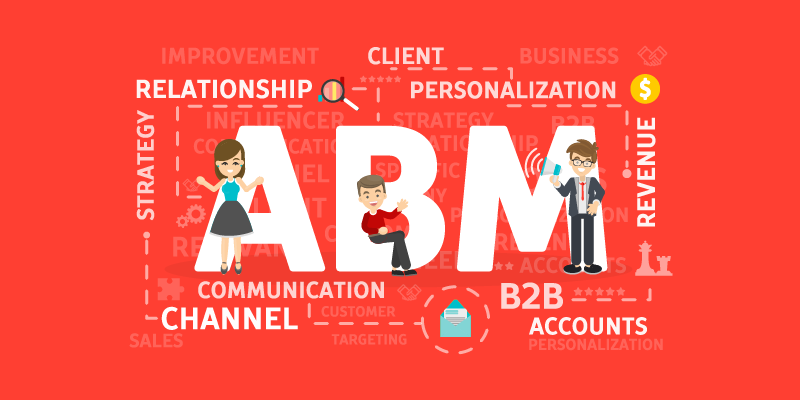
Conversion Rate Optimization: Turning E-commerce Traffic into Leads
January 19, 2024
Choosing Wisely: How to Select the Right BInfluencer Mix for 2024
January 23, 2024In the ever-evolving landscape of sales and marketing, the quest for efficiency has become paramount. This section delves into the historical progression of sales strategies, contrasting traditional methods with contemporary approaches. Additionally, we explore the emergence of Account-Based Marketing (ABM) as a strategic paradigm shift, setting the stage for the pivotal role artificial intelligence (AI) plays in enhancing sales efficiency.
A. The Evolution of Sales Strategies
1. Traditional Sales vs. Modern Approaches
Traditionally, sales teams cast wide nets, targeting broad audience segments in the hope of capturing potential leads. This shotgun approach often resulted in wasted resources and missed opportunities. In the modern era, sales strategies have pivoted towards precision targeting, focusing on specific high-value accounts. This shift allows for a more personalized approach, aligning with the preferences and needs of targeted clients.
2. The Rise of Account-Based Marketing
Account-Based Marketing (ABM) has emerged as a strategic beacon in the modern sales landscape. ABM flips the script by concentrating efforts on a select group of high-potential accounts, aligning marketing and sales activities for a more cohesive approach. This not only enhances targeting precision but also fosters deeper relationships with key clients. The rise of ABM signifies a departure from the one-size-fits-all mentality, emphasizing quality over quantity.
B. The Imperative of Efficiency
1. The Competitive Landscape
In today’s cutthroat business environment, gaining a competitive edge is non-negotiable. Businesses that fail to adapt to the changing dynamics of customer engagement risk falling behind. Sales teams are under constant pressure to streamline processes, maximize resources, and deliver results efficiently. The integration of AI into ABM provides a strategic advantage by automating tasks, allowing sales professionals to focus on high-value activities that drive revenue.
2. Demands on Modern Sales Teams
The expectations placed on modern sales teams are multifaceted. Not only are they tasked with closing deals, but they also bear the responsibility of nurturing client relationships. With customer expectations soaring, sales teams must navigate complex buyer journeys with finesse. AI becomes a valuable ally, offering predictive analytics and personalized automation that empowers sales professionals to meet and exceed client expectations.
Understanding Account-Based Marketing (ABM)
In this section, we embark on a comprehensive exploration of the foundational principles that underpin ABM. By dissecting the methodology and benefits of ABM, we gain insights into why it has become the preferred approach for forward-thinking sales teams.
A. Defining Account-Based Marketing
1. Precision Targeting
At the heart of ABM lies precision targeting. Instead of broadcasting messages to a wide audience, ABM identifies and focuses on specific high-value accounts. This targeted approach ensures that marketing efforts resonate with the unique needs and pain points of individual clients. Precision targeting enhances the efficiency of marketing campaigns, resulting in a higher conversion rate and increased customer satisfaction.
2. Personalization at Scale
While personalization has always been a hallmark of effective sales, ABM takes it a step further by enabling personalization at scale. AI algorithms analyze vast amounts of data to discern patterns in client behavior, allowing for the delivery of tailored content and experiences. This level of personalization not only strengthens client relationships but also significantly boosts the chances of conversion.
3. Relationship-Centric Approach
ABM is inherently relationship-centric. By concentrating efforts on a select group of accounts, sales teams can develop deeper, more meaningful connections. This approach fosters trust and loyalty, essential components in today’s business landscape. AI augments this relationship-centric strategy by providing actionable insights, enabling sales teams to engage with clients at precisely the right moments.
B. ABM vs. Traditional Marketing
1. Target Audience Differentiation
In traditional marketing, the focus is often on reaching as many individuals as possible. ABM, on the other hand, is about quality over quantity. By differentiating the target audience and tailoring strategies to specific accounts, ABM ensures that marketing efforts are invested where they are most likely to yield results.
2. ROI and Effectiveness Metrics
ABM’s effectiveness is not only measured in lead generation but also in Return on Investment (ROI). Traditional marketing may generate a higher quantity of leads, but the conversion rate and overall impact may be lower. ABM, with its focus on high-value accounts, often delivers a more favorable ROI, making it a strategic choice for businesses looking to maximize their marketing budget.
C. The Role of AI in ABM
1. Enhancing Data Analysis
AI excels at processing vast amounts of data swiftly and accurately. In the context of ABM, this capability is harnessed to analyze customer data, uncovering insights that inform targeted marketing strategies. The ability to process and interpret data at scale enables sales teams to make informed decisions, ensuring that every interaction is purposeful and tailored to the individual client.
2. Predictive Lead Scoring
Predictive lead scoring is a game-changer in ABM. AI algorithms analyze historical data to predict which leads are most likely to convert. This not only saves time for sales teams but also ensures that efforts are concentrated on leads with the highest potential value. Predictive lead scoring, powered by AI, enhances the efficiency of lead qualification, contributing to higher conversion rates.
3. Automation for Personalization
AI-driven automation in ABM goes beyond mere efficiency; it enables personalization at scale. From personalized email campaigns to targeted content recommendations, AI automates processes while ensuring that each interaction is tailored to the unique preferences of the client. This level of automation not only saves time but also enhances the overall customer experience.

AI-Powered Tools Transforming ABM
In this section, we explore the advanced tools leveraging artificial intelligence to enhance the capabilities of Account-Based Marketing.
A. Predictive Analytics
1. Unveiling Future Trends
Predictive analytics, fueled by AI, transcends traditional data analysis. It not only provides insights into current customer behavior but also forecasts future trends. By analyzing historical data, AI algorithms can identify patterns and predict potential shifts in market demand, enabling businesses to proactively adjust their ABM strategies.
2. Anticipating Customer Needs
One of the key strengths of predictive analytics in ABM is its ability to anticipate customer needs. By analyzing past interactions and behaviors, AI can predict what products or services a customer might be interested in next. This foresight empowers sales teams to tailor their offerings, providing a more personalized and satisfying customer experience.
B. Machine Learning Algorithms
1. Personalized Content Recommendations
Machine learning algorithms play a pivotal role in curating personalized content recommendations. By analyzing a user’s past interactions, preferences, and behavior, AI can predict what type of content will resonate most with each individual. This level of personalization not only enhances engagement but also contributes to the overall effectiveness of ABM campaigns.
2. Adaptive Campaign Optimization
Traditional marketing campaigns often follow a set schedule, but AI-driven ABM introduces adaptive campaign optimization. Machine learning algorithms continuously analyze campaign performance in real-time, adjusting strategies based on evolving customer behavior. This adaptability ensures that marketing efforts are always aligned with the dynamic preferences of the target audience.
C. Chatbots and Virtual Assistants
1. Real-time Engagement
AI-driven chatbots and virtual assistants are revolutionizing real-time customer engagement. These tools, powered by natural language processing and machine learning, can provide instant responses to customer queries. In an ABM context, this translates to immediate and personalized interactions with key accounts, fostering a sense of responsiveness and attentiveness.
2. 24/7 Customer Interaction
Unlike human agents, AI-powered chatbots and virtual assistants operate round the clock. This 24/7 availability is a game-changer in ABM, especially when dealing with global clients across different time zones. Ensuring constant accessibility enhances customer satisfaction and allows businesses to maintain an ongoing dialogue with key accounts.
Implementing AI in Your ABM Strategy
Now that we’ve explored the capabilities of AI in ABM, it’s crucial to understand how to seamlessly integrate these technologies into your existing strategy.
A. Selecting the Right AI Solutions
1. Customization for Your Business
The key to successful AI implementation in ABM is customization. Businesses must carefully select AI solutions that align with their unique needs and goals. Whether it’s predictive analytics, machine learning, or chatbot technology, the chosen tools should integrate seamlessly with existing systems and workflows, ensuring a tailored approach that maximizes efficiency.
2. Integration with Existing Systems
Harmonizing AI tools with your current systems is paramount. The transition should be smooth, with minimal disruption to ongoing operations. Whether it’s integrating AI into your Customer Relationship Management (CRM) system or aligning it with your content management platform, a well-executed integration ensures a cohesive and effective ABM strategy.
B. Overcoming Implementation Challenges
1. Data Security Concerns
As with any technological advancement, data security is a primary concern. Businesses must address potential vulnerabilities and ensure that the implementation of AI in ABM complies with data protection regulations. This might involve investing in robust cybersecurity measures and educating staff on best practices to mitigate risks.
2. Staff Training and Adoption
The successful implementation of AI in ABM requires the buy-in and expertise of your team. Providing comprehensive training on the new tools is essential to ensure that staff members can leverage AI effectively. Additionally, fostering a culture of adaptability and innovation within the organization encourages the seamless adoption of AI technologies.
C. Measuring Success
1. Key Performance Indicators (KPIs)
Determining the success of your AI-driven ABM strategy involves monitoring specific Key Performance Indicators (KPIs). Metrics such as conversion rates, lead scoring accuracy, and customer engagement provide tangible insights into the impact of AI on your sales efficiency. Regularly analyzing these KPIs allows for continuous refinement and optimization of your ABM approach.
2. Continuous Improvement Strategies
AI is not a one-time solution; it’s a dynamic tool that evolves with your business. Continuous improvement strategies should be implemented to refine and adapt AI-driven ABM practices. Regularly assess the performance of your AI tools, gather feedback from your sales team, and stay abreast of technological advancements to ensure your strategy remains cutting-edge.
Challenges and Future Trends in AI-Driven ABM
While the integration of AI into ABM brings unprecedented benefits, it’s crucial to acknowledge the challenges and look ahead to future trends that will shape the landscape.
A. Overcoming Resistance to Change
1. Cultural Shifts within Organizations
One major hurdle in implementing AI-driven ABM is resistance to change. Organizations must foster a culture that embraces innovation and agility. Educating teams on the benefits of AI and creating a collaborative environment can help overcome resistance, ensuring a smooth transition to AI-enhanced strategies.
2. Building Trust in AI
Another challenge lies in building trust in AI among team members and clients. Transparency about how AI algorithms work, coupled with clear communication on their role, helps demystify the technology. Establishing trust is paramount to successful AI integration and ongoing collaboration.
B. Future Trends in AI-Driven ABM
1. Integration with Emerging Technologies
The future of AI in ABM involves integration with emerging technologies. As Artificial Intelligence continues to evolve, its synergy with technologies like augmented reality and virtual reality will unlock new dimensions of customer engagement. Businesses should anticipate these developments to stay ahead in the competitive landscape.
2. The Role of AI in Hyper-Personalization
Hyper-personalization, enabled by AI, is poised to become a defining trend in ABM. AI algorithms will delve even deeper into individual preferences, crafting experiences that go beyond personalization to anticipate needs before they arise. The future of AI-driven ABM lies in creating seamless, anticipatory interactions that leave a lasting impression.
Conclusion
In this comprehensive journey through the integration of AI into Account-Based Marketing, we’ve uncovered the transformative power of precision targeting, personalization at scale, and the relationship-centric approach of ABM. AI has emerged as the catalyst for boosting sales efficiency, providing tools that not only automate processes but also elevate the entire customer experience. As we navigate the evolving landscape of sales strategies, the path forward involves immediate action steps and a commitment to continuous adaptation to remain at the forefront of the dynamic business environment.





